




| Home | Features | Club Nights | Underwater Pics | Feedback | Non-Celebrity Diver | Events | 8 August 2025 |
| Blog | Archive | Medical FAQs | Competitions | Travel Offers | The Crew | Contact Us | MDC | LDC |

|

|
 
 |
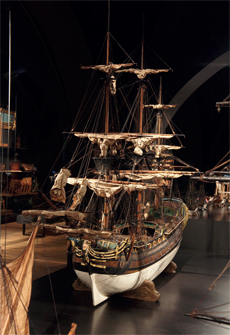 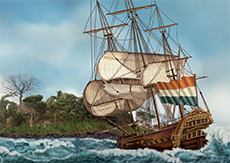  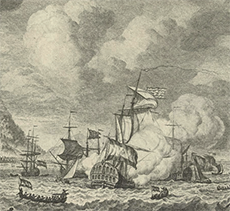 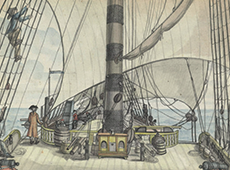 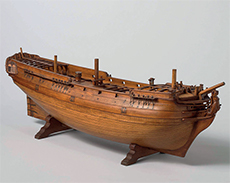 ISSUE 22 ARCHIVE - THE VANISHING DUTCHMANLeigh BishopA mysterious cannon shipwreck off the coast of Africa intrigued an international team to investigate further. Mounting an expedition based on a remote jungle Island was an adventure of a lifetime; Leigh Bishop explains how a masterpiece of detective work uncovered one of the most intriguing shipwreck stories of all time."With the midday sun high in the sky, light levels and visibility in such a shallow depth could not have been better. American Kiersten Mottl was close by my side as we worked our way through the wreckage spread across the rocky reef. A hint of gold had caught her eye and raised excitement. According to records of lost ships along the African coastline, this wreck could possibly be one to have been carrying gold. Or so we thought. Although not treasure hunters, we were excited to say the least. A clear and obvious buzzing in her earphones from the underwater metal detector had picked up a promising lead beneath the seabed. As she dug in the sand the bright sunrays sparkled from a beautiful gold ring. Would our mystery wreck reveal its name and if so was it carrying a cargo more exciting than we could ever have imagined? Sierra Leone is not a destination that crops up too often on the radar of dive destinations. This was a true expedition like I had never experienced before. A chance to base myself on a remote jungle island, with a group of international divers exploring a shipwreck, possibly 300 years old. At 10m the wreck was shallow, and close to shore. Could it have been a heavily armed slave ship that found her demise in a bad storm? This part of Africa, and particularly Sierra Leone, was a well - known slave trading location. Kiersten and I rolled over the side of the small banana boat for a second dive of the day. Our task was to search amongst the rocks of the reef for signs of porcelain or cargo. Better still anything that would give us a clue as to the wrecks name and the mystery of why it ended its life here on the reef at the western tip of Banana Islands. Towards the south-western end of the wreck fragments of porcelain had been found, perhaps a stern cargo area, located in a lower hold. Dives would last approximately an hour with no decompression; visibility was good and working as a team made each task easier. The first two weeks of the expedition were spent documenting a full analysis of the site. Kiersten along with Mark 'Sharky' Alexander also from the USA worked with me to set up an archaeological grid system to systematically photograph each section with a view to making a larger photomosaic of the entire site. We had recorded 29 cannon and five anchors, indicating this was no small ship. So how exactly did this African adventure begin? The previous year I took a call from a good friend, polish diver Peter Wytykowski. Peter was making a second expedition and had asked me to join him. "It's not deep" he said "but logistically it will be quite challenging". Peter knew a Greek diver by the name of Greg Delichristos. Delichristos, a diver himself, had stumbled on the wreck whilst travelling across Africa. Peter told me it wouldn't be easy, he was right. Sierra Leone is one of the poorest countries in the world. It is home to some serious health issues, not to mention world epidemic outbreaks, such as Ebola. A virus that spawned its life as we were there. Many painful injections and weeks of prescribed drugs were required before even entering the country and long after leaving. Arriving in the capital city of Freetown, several days were spent navigating our way through bustling streets in search of the supplies that would be needed on Banana Island, the remote island where the shipwreck was located. There was little if anything on the Island and everything would have to be taken with us. We had intended to build our own airlift to excavate the seabed below the reef and in doing so we would need not only compressors to fill cylinders daily but also to drive any such lift from a surface dive boat. In order to undertake a full archaeological analysis of the site as well as recover artifacts for scientific investigations a permit to work from the Sierra Leone government was granted. Solving problems and repairing equipment in a third world country would become the norm. If we had not brought it with us we had to build or make it. Being based on a jungle island meant living in a very symbolic relationship with the surrounding fauna. The only barrier at night from an unpleasant touch of a spider or a scorpion was a mosquito net over my bed. On one occasion a deadly 2m long cobra snake was smoked out of my bamboo hut with the help of local villagers! Diving continued on the wreck site for almost three weeks. Hundreds of images were taken and all the cannon were fully documented. Markings discovered on the cannon indicated they were Swedish guns made by a company who were supplier of cannons for the Dutch market. Fixtures on our wreck were common to finds on other Dutch East Indiamen wrecks discovered around the world. Our field expedition in Sierra Leone sadly revealed no solid evidence as to the wrecks exact name. Ebola had become a global epidemic; a follow up expedition was most certainly out of the question. The layout of the wreck on the reef indicated that the ship most likely came close to the island with her stern to the west. Did she shelter from a ferocious storm or was she pushed onto the reef from a high sea state? The position of the cannon and anchors indicate that her port hull was almost level alongside the shore. The location of porcelain and other fragments of cargo suggest her keel was in slightly deeper water but almost touching the reef. The Question as to if the crew survived remained a mystery. Did they go ashore and if so did they survive in the jungle if confronted by local natives. Questions remained unanswered. Our fieldwork in Sierra Leone laid a good foundation to work from but we knew it was now a case of some serious research. Wood samples chemically analyzed by experts proved a fire at some point, whilst ceramic specialists dated the porcelain to the 2nd quarter of the 18th century approx. 1725-1750. Through a sequence of events I then came into contact with a researcher by the name of Arthur Scheijde from the Netherlands. Arthur had access to the Dutch National Royal Library at The Hague and through some ingenious research put us on a detective path to the wrecks true identity. We then looked at a ship named DIEMERMEER, previously ruled out as documents stated her wrecked somewhere off the coast of Guinea. Arthur pointed out Sierra Leone was smack bang below that area, which in theory, was, on a grand scale, between the Cape and Holland, very close to our wreck site. From our fieldwork in Sierra Leone we concluded the cannon were manufactured for the VOC chamber of Amsterdam. Diemermeer was also from Amsterdam. Then in a hidden document we found a paragraph of words: "The Dutch ship Diemermeer, returning from Ceylon without a Cape call, was becalmed off the Guinea coast in 1747, losing all but nine of her crew. Her hempen cable eventually parted and she ran on shore where she was pillaged and burnt by villagers. There were only two survivors". Chemically analysed timber from the wreck site proved at some stage there was a fire on-board. Diemermeer was fast becoming a strong candidate for our mystery shipwreck. We then discovered a newspaper clipping from July 1748 that mentioned the fire in more detail. It also mentioned the Banana islands! Our mystery shipwreck was The Diemermeer. Built in 1736 for the Dutch East India Company in Amsterdam. She served as a trade ship between the Dutch East India colonial territories and the Netherlands homeland from 1737 to 1747. Diemermeer was homebound from Ceylon, now known as Sri Lanka, having travelled for seven long months. In August of 1747 the remaining crew alive had landed near the Banana Islands with only around ten men left. All were sick including the captain. Anchor was dropped close to shore and rescue shots fired for three days straight. No one came to the rescue. In a desperate attempt they cut the anchor rope leaving the ship to drift towards shore, all but two men went into the jungle to seek help. Archive documents then state that 'several hundred negroes' appeared from the jungle rushed to the ship, plundered everything they could carry off and then set fire to her. In the Dutch province of Zeeland the ship Unicorn captained by Klaes Pietersz had returned from the coast of Guinea in 1748 with news. On December 25th 1747, along the African coastline, the Unicorn had met with another Dutch ship who's captain went by the name of Jonas Rust. Rusts ship was named 'The Blessed Sugarcane'! Rust knew of Diemermeers fate and Pietersz would carry the news back to the Netherlands to arrive in July the following year. Rust would stay on the African coastline to continue his business. From archival material it appears that The Blessed Sugarcane was in the vicinity when the Diemermeer arrived at Banana Islands. As the islanders plundering and set fire to the ship Rust had saved two men whom remained aboard to guard their ship. Rust worked for the MCC, the Middelburgse Commercie Compagnie. Few records exist of these particular traders due to the nature of their work. The Blessed Sugarcane was a slave ship! The saved men had not known what had happened to the remaining crew, assuming they had been murdered in the jungle. Diemermeer was not a slave trader and the indigenous people would not have known this, they most certainly would not have welcomed the crewmembers on their island politely. Experts identified the porcelain from the wreck as Batavia style, Kang shi dynasty vintage. From this evidence research continued at the National Archives in Sri Lanka and documents dated May 1st 1746 specified consignments of indigenous medicines of Ceylon were sent to Batavia (today Jakarta) by various ships including the Diemermeer. Not only had we identified our shipwreck and her demise, we had now begun to piece together Diemermeers work around the Indian Ocean. What we discovered next was quite extraordinary. The original navigational map Diemermeer had used on her final voyage around the world. These maps are very rare, hand drawn and were usually destroyed when new maps were made. Only about a dozen are known to exist. VOC maps with a ship's passage drawn onto them are more rare, and that's exactly what we had. On it we could just make out a course plotted either by the navigator or Captain. By digitally enhancing the markings we revealed, quite literally the last voyage of our ship. Their passage makes way around the Cape of Good Hope, into the Indian Ocean following the south West Indian ridge and directly across to Amsterdam Island. From there they made passage north to Ceylon then westbound to Java. Her final passage took them via Cocos Islands all the way back across the Indian Ocean stopping in South Africa before heading northbound to Sierra Leone. We can only assume this map was left in south Africa and a new one was taken on board for the remainder of the voyage. Why the entire crew but ten perished remains a mystery? Was it scurvy or did they succumb to an ill-fated death from indigenous African tribes elsewhere? The divers were: Peter Wytykowski, Mark 'Sharky' Alexander, Robert Gluchowski, Kiersten Mottl and Leigh Bishop. |